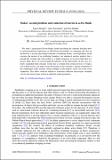Stokes' second problem and reduction of inertia in active fluids
Author(s)
Townsend, Alex; Slomka, Jonasz Jozef; Dunkel, Joern
DownloadPhysRevFluids.3.103304.pdf (2.369Mb)
PUBLISHER_POLICY
Publisher Policy
Article is made available in accordance with the publisher's policy and may be subject to US copyright law. Please refer to the publisher's site for terms of use.
Terms of use
Metadata
Show full item recordAbstract
We study a generalized Navier-Stokes model describing the coherent thin-film flows in semiconcentrated suspensions of ATP-driven microtubules or swimming cells that are enclosed by a moving ring-shaped container. Considering Stokes' second problem, which concerns the motion of an oscillating boundary, our numerical analysis predicts that a periodically rotating ring will oscillate at a higher frequency in an active fluid than in a passive fluid, due to an activity-induced reduction of the fluid inertia. In the case of a freely suspended fluid-container system that is isolated from external forces or torques, active-fluid stresses can induce large fluctuations in the container's angular momentum if the confinement radius matches certain multiples of the intrinsic vortex size of the active suspension. This effect could be utilized to transform collective microscopic swimmer activity into macroscopic motion in optimally tuned geometries.
Date issued
2018-10Department
Massachusetts Institute of Technology. Department of MathematicsJournal
Physical Review Fluids
Publisher
American Physical Society
Citation
Słomka, Jonasz, et al. “Stokes’ Second Problem and Reduction of Inertia in Active Fluids.” Physical Review Fluids, vol. 3, no. 10, Oct. 2018. © 2018 American Physical Society
Version: Final published version
ISSN
2469-990X
2469-9918